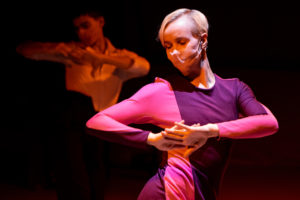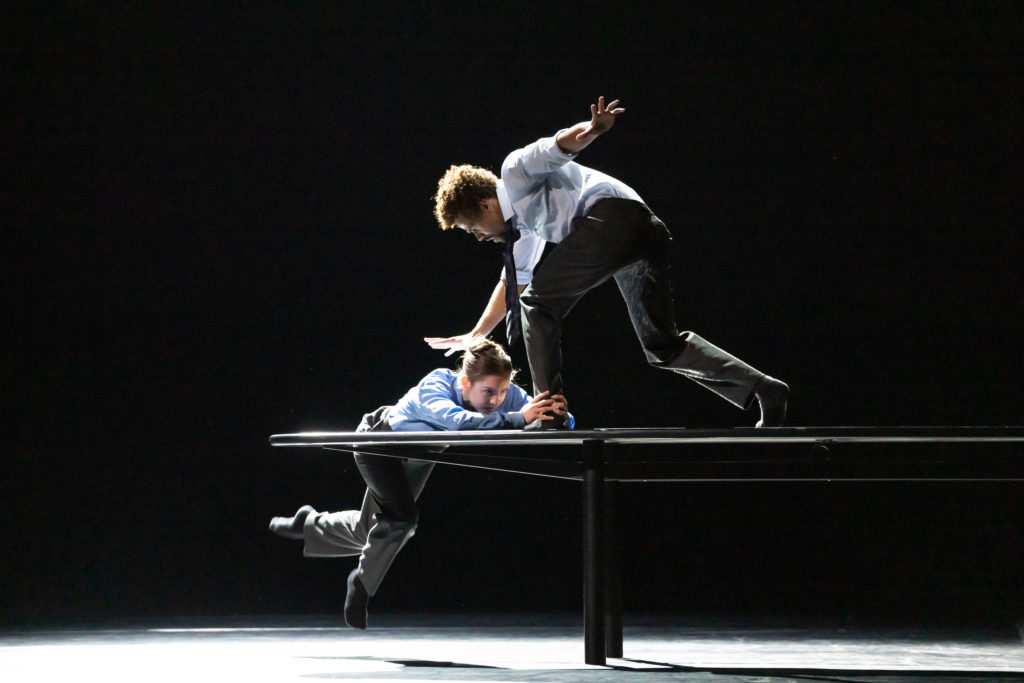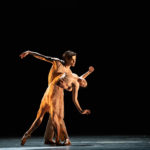London’s reopening - Vancouver Ballet Society
- Home
- City Reports 2020 - 2023
- London’s reopening

By Sanjoy Roy
Theatres began to reopen in London in June, and guess what we all talked about? COVID. For all sorts of reasons — practical, social, medical, economic — it keeps a grip on the dance world, and it was impossible to attend dance without sensing its enduring and pervasive presence.
Though created before the COVID crisis, Alexander Whitley’s Overflow had been postponed twice because of it. Its premiere was the first theatre performance I had seen in London for more than a year, and even getting into Sadler’s Wells was a startlingly different experience: e-tickets and programs sent to mobile devices, spaced-out queues and timed entries, location logging through QR codes for test-and-trace compliance, no foyer-loitering, an auditorium sparse with mask-wearers. Weirder still was the stab of recognition that this isolating, socially impoverished itinerary — get in, see the show, get out — was alarmingly close to the standard experience of the jobbing critic. And that can’t be good.![]()

What of the show? Overflow was highly skilled, finely tuned and well conceived, performed and produced; was it the pandemic that made me yearn for more nourishment? Perhaps it was — so let me dwell instead on its pleasures. It is built around three elements. First and very often foremost, is a deceptively simple-looking light installation by Dutch designers Children of the Light, complemented with stage lighting by Guy Hoare, which together work wonders: laser beams focus and fracture, scanning the stage or sending out sparks like tracer bullets, with glows and pulses evoking both the macrocosmic and the subatomic. The same feel comes from the sound score by music producer Rival Consoles which, layering pixel-sharp notes with smudgy noise and chopped words, mixes fine detail with general dread.
Still, it’s the choreography I go for. Whitley, a Sadler’s Wells associate artist, has always had a facility for choreographing groups, avoiding blocks and geometries in favour of more slippery forcefields, tangles and ricochets. Overflow features six highly fluent dancers in a suite of short scenes, each a little world unto itself, with its own lighting, dynamics and sound. One, built around held hands, is full of ribbony slipknots; another has the stop-frame effect of a graphic novel, all shadows and frozen action; others seem both aerial and underwater, as if not quite of this earth. Each offers its own fascinations even if, in the end, they don’t quite add up to a piece.

It’s common for stage choreography to be adapted for film, but Wim Vandekeybus’ pandemic production Draw from Within flipped that process: commissioned for online broadcast as part of Rambert’s lockdown program last year, it has now been adapted for live performance. The online version — reviewed in Dance International in October 2020 — followed the dancers through various locations in Rambert’s headquarters, the camerawork fully incorporated into the dance, to dynamic effect. How would it translate to the Sadler’s Wells stage, where we watch a single space from fixed seats? Remarkably well, as it turned out. That’s partly because Draw from Within was designed for livestreaming, and is (like Whitley’s) a suite of broadly self-contained scenes, each with its own effects and ideas; but it’s also thanks to Rambert’s knockout dancers, who ranged over the space with a combination of poise, precision and explosiveness that packed a physical punch way back into the auditorium.
The scenes themselves are a ragtag bunch, spanning the highly figurative — a woman “birthing” a grown man, who scuttles about on a tiny tricycle, episodes from what you might call “surreality TV,” a nightmarish hospital bed, complete with blind zombie slasher — to the highly physical: swooping about with smoking sticks to fill the air with motion trails, or careening across the stage at precipitous angles, tugging taut ropes like wire slicers. All these effects “read” somewhat differently than the online version — how could they not? — but it is recognizably the same wayward, unpredictable and very visceral piece.
If the pandemic forced a lot of dance onto the screen, the return of live performance is not going to take it off again, because you can’t argue with numbers. The Royal Opera House digital platforms, for example, together logged 787 million views over the year, with more than nine million views of their free Friday Premiere streams of opera and ballet productions, and 200 countries reached though YouTube. Restricted audience numbers for live events only emphasize the importance of digital strategy for arts organizations.

I was able to catch the Royal Ballet’s two reopening programs — both showcasing modern and contemporary rather than classical ballet — from where I was staying outside London. For fans of the three Crystal Pite/Jonathon Young collaborations (count me in) the highlight of the first program was the opportunity to see The Statement, created for Nederlands Dans Theater in 2016. As with their other two pieces, this is a virtuoso experiment in pinning gestural movement to the exactitude of speech. Here, they enact a high-tension drama of political and institutional paranoia that remains entirely suited to our times — although the Royal dancers don’t have the whiplash snap of Pite’s own company, or that I remember from NDT. They’re better suited to Pite’s more fluid Silent Echo (2012), which followed, a darkly introspective ensemble work built upon a low, loping run that suggests not escape, but dogged determination.

In the context of the pandemic, Christopher Wheeldon’s lyrical Within the Golden Hour feels like a comfort break — glisteningly lovely, but so smooth there’s nothing to snag the soul. More intriguing is the new Optional Family: A Divertissement by American choreographer Kyle Abraham, a brief foretaste of a longer work to be premiered next year. The trio, for principals Natalia Osipova and Marcelino Sambé, joined by young corps de ballet dancer Stanisław Węgrzyn, is a portrait of what we take to be a couple and a child — or some third figure — whose presence complicates an already fractious bond. It’s fascinating for its mix of intimacy with artifice — balletic batterie, a strangely stilted voiceover reading highly emotive letters from a marriage.
Once this program of 21st-century choreography, and the Royal’s subsequent bill of 20th-century work by Balanchine (Apollo, Tchaikovsky Pas de Deux) and Robbins (Dances at a Gathering), finished their live London runs, they remained available for a time for online viewing, thanks — I guess I have to say — to the pandemic.
The Royal Ballet’s Balanchine/Robbins mixed bill remains online until 11 July.

